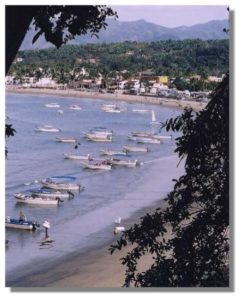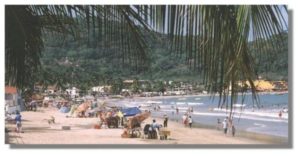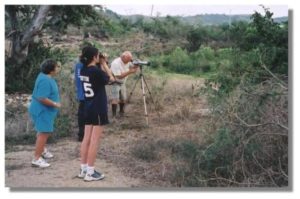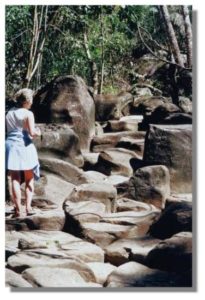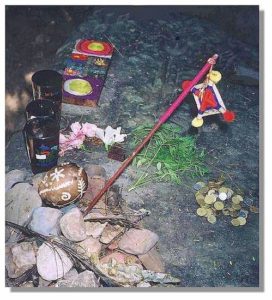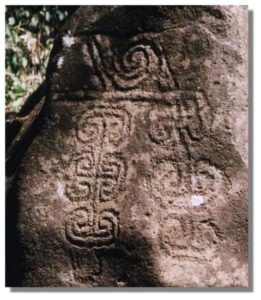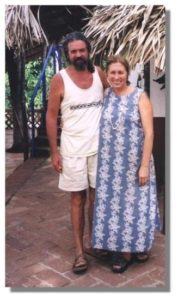An earlier article on the easy-going beachside town of Guayabitos focused on the services the town offers and on activities within easy walking distance. Most people staying more than a few days begin to get itchy feet and wonder if there is anywhere worth visiting a little further afield. This article suggests some possible side-trips (half a day required) within a short drive of the town. A rental car or taxi is your best bet in terms of flexibility, though really intrepid travelers could also reach these places using public transport, provided time is no problem and they are fully prepared to walk the last few kilometers in the hot sun.
Let’s start by exploring the coast.
Playa Los Ayala and Playa del Beso
At the southern edge of town, a paved road goes west to the village of Playa Los Ayala, where there are dozens of rooms and self-contained apartments for rent. In fact, it looks remarkably like Guayabitos did 25 years ago! The beach is good, and while frigate birds circle overhead, why not enjoy a coconut (12 pesos, just over a dollar) or a bag of churritos (5 pesos)? Five minutes walk from the far end of the beach is a path over the hill to Playa del Beso. The path winds through a veritable jungle of luxuriant fan palms and big burseras with their distinctive green, peeling bark before revealing a charming small cove, an ideal location for a quiet sunbathe, away from the masses.
Punta Raza
Next, Punta Raza, the real undiscovered gem of all the (easily accessible) beaches. Return to the main highway (Federal highway 200) and then turn south for about 5 kilometers as far as Monteón. Turn right (west) off the highway into the small village and continue along the cobblestone road almost to its end. Look for a large sign on the right hand side announcing the turn to “Un Rincón del Cielo”. This road quickly becomes a rough, but passable, track that crosses a small stream and then climbs the hillside before descending steeply on the other side through the coconut palms.
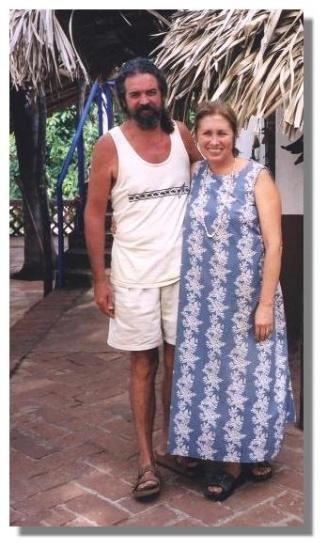
At the end of the track is Rincón del Cielo, an informal restaurant-hotel perched above a spectacular, deserted beach, separated from Playa del Beso by the rocky point of Playa Raza. What makes this find so rare is that the restaurant, while it may look rustic and unpretentious, serves outstanding food. The restauranteurs are two genuine “get away from it all” types, Juan Bernal and María Graciela Zavala, who moved here in 1999. In this small restaurant, part way up the cliff side, overlooking the beach and the boundless ocean, they serve only the finest of cuisine. However, do not expect to find an extensive written menu, since everything depends on what is available. Simplicity is the order of the day. Ask Juan or María what they recommend and then choose from their two or three suggestions. Whatever you choose, you are unlikely to be disappointed.
We chose “shrimp” and then set off for a walk on the beach while the meal was being prepared in the open kitchen. Down a few steps, the fine sand invites you to stroll or paddle your way to the far end of the bay, some two kilometers away, where a sizeable lagoon offers some great bird-watching opportunities. There is only very limited shade on this beach but the hotel has thoughtfully provided a small canopy below its property to offer shade-lovers a chance to enjoy the surroundings.
Returning an hour or so later, we found the table laid with elegant place settings, complete with fresh flowers. Drinks from the bar in hand, we sat down to a truly excellent meal. A fresh green salad, with hints of exotic flavors, was followed by perfectly cooked devilled shrimp, accompanied by rice and the freshest of green beans, a real rarity in most parts of Mexico. Dessert and a cool beer… what more could one ask for, if not for a suitable place to take a siesta? A hammock to one side of the restaurant, swaying gently in the breeze, beckoned…. zzz…. zzz.
For those who want to stay longer, María and Juan have several rooms for rent. They are simple, but spotlessly clean, and the setting more than makes up for any lack of amenities. Look for Juan’s exquisite personally-designed parota-wood furniture. In all there are eight rooms available, ranging from a unique circular “ivory tower” to some simple double rooms sharing outside plumbing. And no need to pack electric curling irons, hairdryers, rechargers etc. because the hotel has only limited electricity and none of the rooms are hooked up. As an aside, their business card takes an amusing but accurate one-upmanship approach to all those 5-star resort hotels elsewhere, describing Un Rincón del Cielo as ” un playa hotel de mil estrellas” (a beach hotel of a thousand stars).
Rates averaged about US$50 a room in early 2003. Reservations can be made by leaving your phone number and contact details (in Spanish or English) at 011-52-(327) 274-7070 in Monteón. Alternatively, you can contact Villas Buena Vida in Guayabitos. The owners, good friends of María and Juan, are happy to help you find this hidden treasure and can usually relay your message to them within a day or two.
My next ambition? To return here with my family during September or October and watch the turtles (laying eggs?) on the beach. Or perhaps I’ll take that sabbatical I’ve been talking about and retreat here on my own to finish that book….
Lo de Marcos
If you still haven’t seen enough beaches, then head 8 kilometers further south along the highway and turn in to Lo de Marcos, a small, quiet village with several unpretentious hotels. From Lo de Marco a short coastal road continues further south to two even smaller, and more secluded, beaches: Playa Las Minitas and Playa El Venado. The former has several palapa restaurants. At El Venado, waves crash onto the rocks at one end of the bay, splashing foam into the branches of a lovely white-flowering bombax tree.
Inland, away from the beaches: Altavista
For a completely different experience, consider making the pilgrimage to a Prehispanic ceremonial center known as Altavista, on the lower slopes of the Sierra de Vallejo. From Rincón de Guayabitos, head north along Highway 200 for about 15 kilometers, turning off to the right (southeast) when you see the Altavista sign. Take this road, and turn left after approximately 2 kilometers, followed by a right turn after a further one kilometer. You should leave your vehicle at this junction if it does not have high clearance, since the track after this point becomes quite rough. The entrance to the Altavista sanctuary is about 25 minutes walk down the track, on either side of which are plantations of guanabana (soursop) and other fruit trees. Guanabana, incidentally, is an unusually shaped and distinctively flavored fruit. The track crosses private property (close the two rustic barbed wire gates behind you) before ending at a large open space (perfect for parking high clearance 4-wheel drive vehicles).
The path inside the sanctuary parallels the bed of the Piletas creek and leads you a kilometer or two up the valley, offering plenty of shade. Known to cover an area of at least 80 hectares, the site contains literally dozens of rock carvings, or petroglyphs, as well as lots of fascinating natural rock formations.
Signs, strategically placed at intervals along the walk, offer ample information (in both Spanish and English) about the history of this area, and some background to the beliefs of the ancient Cora Indians who took the trouble to carve these petroglyphs. Modern-day Cora Indians return, not only to view the work of their ancestors, but also to visit shrines and leave offerings such as god’s eyes, beaded jewelry, corn husk, gourds, ribbons of many colors, and even plastic dolls!
The most impressive rock formations are those tumbling down the stream bed like a giant uneven stairway that form the back of the “Pila del Rey” (“King’s basin”). Up the slope, to one side of this, is one of the Cora’s most sacred shrines, that marking the “energy center” of their world.
This rich cultural treasure-trove of the Cora Indians was apparently never found by the Spaniards as they marched to the coast. The petroglyphs were first formally registered in 1995, following a request by a local community museum. The community, together with local landowners, continues to oversee all access to the site, though it is hoped that this role will soon be undertaken by INAH, the federal anthropology and history institute.
What is the meaning of these petroglyphs so laboriously chiseled into the rocks? The scientific study of these rock carvings is still in its infancy, but the earliest have been tentatively dated to around 300 B.C., and most of them were probably made sometime between 900 and 1100 A.D. This means the symbols could span almost 1500 years in age, perhaps developing from simple spirals into far more elaborate representations of cosmic ideas. The spiral could represent the wind, or perhaps a snail? Better yet, it might be the sign for movement. No, it’s the breath of the gods! The precise meaning of all these petroglyphs remains uncertain, so your fanciful interpretation may be just as accurate as that of any archaeologist.
One of the more interesting rocks here has numerous small hollows etched in its surface. According to oral tradition, this is where Cora Indians leave some cotton soaked with tears. The tears represent messages to their ancestors. They are faithfully delivered, either to the underworld (by soaking into the ground) or to the heavens (by evaporation).
Safely back in Guayabitos after exploring the Altavista ceremonial site and speculating on the meaning of life, it just might be time to book a massage at the Villas Buena Vida for Saturday morning. Now, let’s see, should I spend 30 dollars on the 60-minute whole body session, or 20 for a half-hour back-only massage?
Bird-Watching
Another possible diversion from sun and sand, whether on the coast, or inland, is to spend a few minutes bird-watching. This part of Mexico has some world-renowned birding “hot spots”, places where an unusual number of different species can be found in close proximity – ideal places, in fact, for those avid ornithologists who want to add new species to their life-lists. San Blas, a small town some 60 kilometers (40 miles) due north of Rincón de Guayabitos is perhaps the best known hot spot of all; almost half of the 1050 species ever recorded anywhere in Mexico can be seen within a few kilometers of the town. Not surprisingly, during the winter birding season, it has become a very popular destination for keen birders.
But why go to San Blas when the environs of Rincón de Guayabitos offer an equally good variety of birding habitats, with the exception of extensive mangrove swamps? Barbara and Pat Giffin, two regulars at the Villas Buena Vida, have applied their considerable birding expertise to compiling a list of all the species seen close to Guayabitos and a mighty impressive list it is, too.
This visit, we lucked out, arriving during Barbara and Pat’s last week of their annual extended stay. They graciously offered to take us birding one morning, and we set off along a track east of the highway, through fields of pineapples, millet, bananas and corn as far as a working gravel quarry, now partially flooded, a man-made marshland ideal for seeing water birds.
In a couple of hours, we were introduced to no fewer than 27 different species. From the foliage of crops, beautiful painted buntings called to each other and stared right back at the binoculars, while groove-billed anis, great-tailed grackles and various flycatchers flitted about their daily business. On the edge of the swamp, northern jacanas, disturbed by some movement in the background, took flight, with a characteristic flash of yellow from their wings as they passed by. The nearby egrets and herons remained motionless, standing confidently in the shallows. Several cormorants had their wings spread, warming up in the morning sun. A group of black-necked stilts (they really do look strange!) and sandpipers scurried up and down the sandbanks, searching for breakfast. At the edge of a clump of trees, a flock of colorful Mexican parrotlets squawk a warning before taking off en masse to find a different perch. Barbara and Pat were relaxed and knowledgeable hosts on this trip, helping to ensure that even my teenage kids enjoyed themselves, despite their initial reservations about an early morning walk!
As a reward after birding, we had a leisurely breakfast back in town at the Piña Loca restaurant, where we’d eaten on a previous evening. The Piña Loca is particularly good value. At supper time, it offers a range of daily specials (main plate, drink and dessert) for between 6 and 7 dollars. Unlike most Guayabitos restaurants, its menu includes dishes that are neither Mexican nor seafood. After a few days, when even shrimp and fresh fish begin to tire, this is where you can indulge in Chinese or Italian instead, just for a change.
Update on the town
Like so many places in Mexico, the town is growing rapidly and the signs of change are everywhere. Several new high-rise (5-storey) hotels have opened. We looked at a few of them, but discussion with the kids quickly confirmed that we all still preferred the rooms, ambiance and services of Villas Buena Vida, where nothing ever seems to be too much trouble for the staff and management. The hands-on style of owners Karen and Mark Hofstad and Germán Ramírez keeps everyone on their toes! The rooms are tastefully decorated and thoughtfully furnished with everything you could possibly need during a family vacation, even including a food blender. It’s the little touches that we like, such as the pitcher of cold water in the fridge when you arrive. Every room in the three-storey buildings has a private balcony. Business must be good because the owners have now acquired the next door property, Casa Tranquila. https://casatranquila.com. Following upgrading, the ground floor there, with three bedrooms, two of them specially designed for easy wheelchair access, can now sleep up to 13. The second floor, completely independent, can accommodate a further 8. What a wonderful place this would be for a family get-together!
Where to stay
As the preceding paragraph makes clear, Villas Buena Vida remains our clear favorite, for its combination of efficiency, friendliness and attention to detail. It recently opened its own restaurant, Victor’s, overlooking the beach, and we’re looking forward to sampling the food there, reputed to be excellent, on our next visit.
Where to eat
In addition to the places mentioned above, we ate a couple of times at Toñitas IV. Why the unusual name? Because the same family now has 4 restaurants in town, with very similar menus. The original Toñitas (now known as Toñitas I) is in the Hotel Steffany’s, but, amazingly, does not open on Saturday evenings.
Time change:
The town is in the state of Nayarit, which operates on Mountain Time, one hour behind Puerto Vallarta. Unfortunately, this provides an ample margin to ensure that you have no excuse for missing your return flight!
Copyright 2003 by Tony Burton. All rights reserved.

